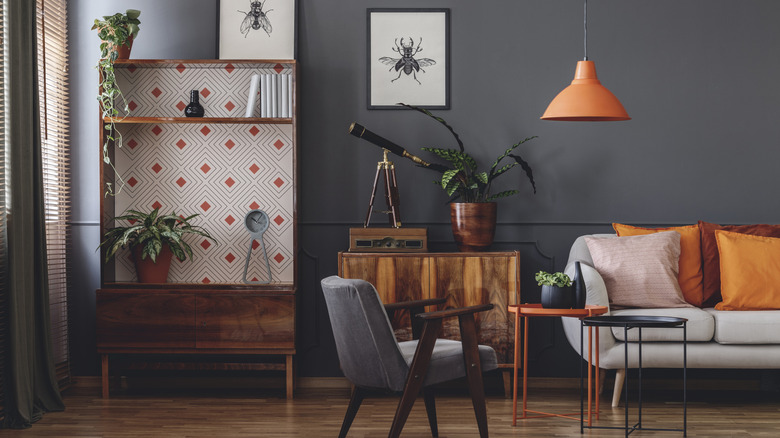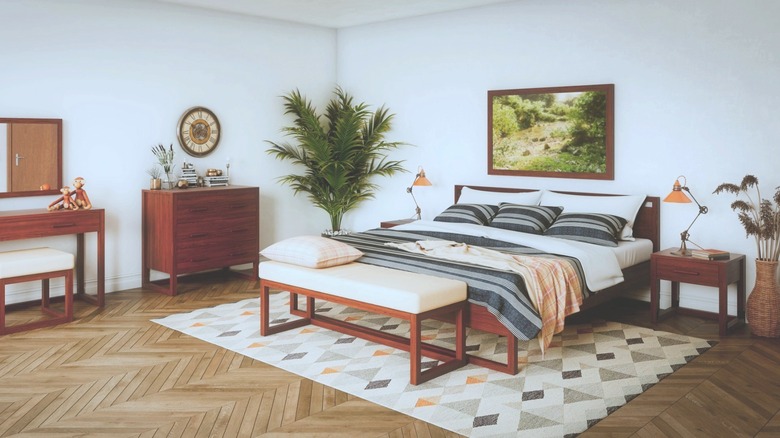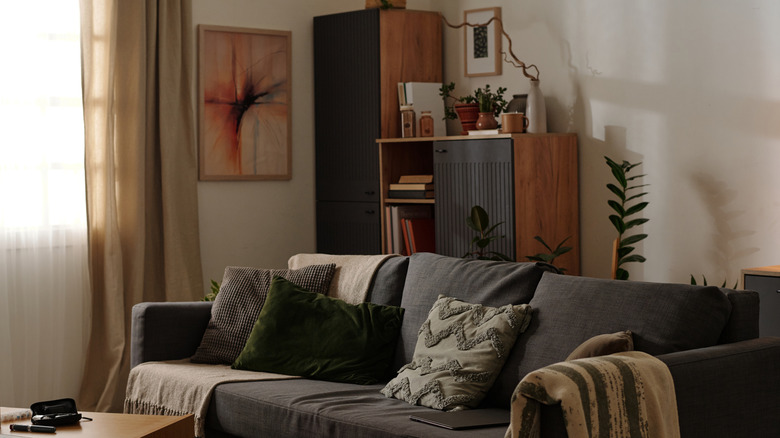How To Make Orange-Toned Wood Furniture And Gray Walls Work Together
Love it or hate it, the millennial gray era of interior design left a profound mark on homes around the world. Even as the 2025 colors of the year continue to demonstrate a move towards more saturated shades, many homeowners and renters alike are still under the reign of neutral gray. Pair that with the lagging furniture sales reported by many major home furnishing retailers, and the result is a mismatch of outdated and hand-me-down orange-toned wood furniture and cool-hued gray walls. Try as you might, the combination struggles to pair well together, often creating an eyesore that is hard to ignore. What's a budget-conscious homeowner or renter to do?
For help, we reached out to Erika Dale, House Digest's interior design expert and Founder of Erika Dale Interior Design. She believes the key to home interior design is to create a profoundly personal oasis that is at once effortlessly functional and aesthetically pleasing. Speaking exclusively with House Digest, Dale said the problem with orange-toned wood furniture is more about the outdated wood stain than the wall color of the room it's in. "These heavily saturated stains bring back not-so-fond memories of the golden oak eighties and nineties," she said.
Even so, if you are trying to use those orange-toned furniture pieces, this wall color might not be doing you any favors. "Gray walls can work for or against you, depending on the undertones in the particular shade," Dale explained. Luckily, Dale assured us there are ways that gray walls can work for you in creating a cohesive look with your orange-toned wood furniture. As with many aspects of design, it all goes back to the fundamentals of the color wheel.
Designing intentionally with gray walls and orange-toned furniture
Making orange and gray work together requires the embrace of the complementary color scheme, which uses opposite colors on the color wheel to guide the design. "Grays with cool blueish undertones will work as the opposing complementary color on the color wheel, meaning the wood will make the paint look bluer and the walls will simultaneously make the stain look more orange when side-by-side," Dale explained, speaking exclusively with House Digest. Far from being a last resort, this is a perfectly valid approach to interior design, and allows for bold pops of color and dramatic focal points in a space, as opposed to an analogous color scheme that utilizes neighboring colors on the color wheel. "Adding contrast also helps avoid the sterile vibes gray walls, especially those with cool undertones, can have," Dale says.
However, you might not want to embrace the stark contrast created by your outdated golden oak-stained furniture. If you are looking to downplay the stain's saturation instead, Dale said the right gray wall color can minimize the orange undertones of those 90s-era furniture stains. How, you ask? The answer lies in greige. "Grays with warmer undertones, like taupes and warmer greiges, are more likely to downplay the orange tones in the wood stain," Dale said. (Check out our list of relaxing greige paint colors for some inspiration.) Warmer undertones in gray paint colors will help draw the walls and your furniture closer together on the color wheel, creating a softer, more cohesive look.
Ways to warm up gray walls and tone down orange wood
The color wheel is also a handy guide to incorporate other colors into your space that will help the gray walls and orange-toned furniture blend together. Just one additional color creates a split-complementary color scheme in which the third color builds harmony between the two opposing complementary colors. Pale yellow or a deep red are two options worth experimenting with in your space. Speaking exclusively with House Digest, Dale explained, "Earth tones ranging from your tone of gray to warmer counterparts will all help make gray walls feel warmer and more alive. Pops of color from there are also always welcome!"
Another strategy is to add various textures and tones to the mix. Woven materials, desaturated wood accents, and a dynamic neutral palette can bridge the gray walls with the orange-toned furniture, according to Dale. For example, if your gray walls have cooler undertones, look for hanging decor elements that add warmth to the walls.
Of course, repainting walls or refinishing furniture are relatively easy, budget-friendly DIY projects that can mitigate your orange-gray woes. (Here's everything you'll need to refurbish wooden furniture.) If you want to refurnish your pieces, Dale said desaturated stains are key. "Light, medium, and dark tones all work to warm up gray walls, as long as they aren't too high in saturation," she explains. As for those gray walls, Dale says that ultimately, undertones make all the difference. "The only way grey walls are going to feel warmer is to pick a gray paint shade with warm undertones, like a taupe or warmer greige," she says, "Anything cooler won't give you a cozy, warm vibe."


